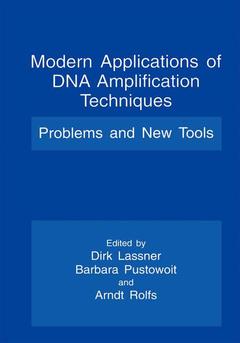Description
Modern Applications of DNA Amplification Techniques, 1997
Problems and New Tools
Coordinators: Lassner Dirk, Pustowoit Barbara, Rolfs Arndt
Language: English
Subjects for Modern Applications of DNA Amplification Techniques:
Keywords
DNA; ELISA; Nucleotide; PCR; Polymerasekettenreaktion; cloning; genes; polymer; reaction; regulation; tissue; transcription
Publication date: 10-2012
143 p. · 17.8x25.4 cm · Paperback
143 p. · 17.8x25.4 cm · Paperback
Description
/li>Contents
/li>
In the ten years since the first publication on PCR (Saiki et al. , 1985), this in vitro method of nucleic acid replication and modification has grown to rival in popularity traditional microbiological, genetical und technical procedures for cloning, sequencing, gene detecting and related procedures. To date the PCR literature has emphasized six main areas of application: genetic mapping, detection of mutations, genetic polymorphism, transcriptional splicing and regulation, molecular virology and quantitative procedures. The overwhelming focus of quantification of DNA or RNA by PCR has been on human microbiology and oncological problems. The exquisite sensitivity of PCR gives this method the ability to detect extremely rare DNAs, mRNAs, mRNAs in small numbers of cells or in small amounts of tissue, and mRNAs expressed in mixed-cell populations. However, the exact and accurate quantification of specific nucleic acids in biological samples is in spite of numerous publications in that field still a general problem: during the peR process, an unknown initial number of target sequences are used as a template from which a large quantity of specific product can be obtained. Although the amount of product formed is easy to determine, it is difficult to deduce the initial copy number of the target molecule because the efficiency of the peR is largely unknown.
PCR Quantification and Technical Aspects: Multiple Competitors for Single-Tube Quantification of HIV1 DNA; T. Vener, et al. Quantitation of p53 Tumor Suppressor Gene Copy Number in Tumor DNA Samples by Competitive PCR in an ELISA-Format; M. Hahn, et al. Standardisation of Messenger RNA Quantification Using an RTPCR Method Involving Coamplification with a Multi-Specific Internal Control; D. Shire, et al. Quantitative Analysis of Human DNA Sequences by Solid-Phase Minisequencing; A.C. Syvänen. Bioimage Analysers: Application for Ribozyme Kinetics; C.S. Vörtler, K. Birikh. First Approaches to Quantitate MDR1Messenger RNA by in cell PCR; D. Lassner, et al. Application of in situ-PCR for Detection of Intracellular mRNAs; V. Uhlmann, et al. Psoralen Biotin: A Novel Reagent for Non-Enzymatic and Specific Labeling of Nucleic Acid Probes and Oligonucleotides; R.L. Burghoff, et al. The Effect of Quantitative Ratio between Primer Pairs on PCR Products in Multi-Target Amplification; D. Bercovich, et al. PCR Quantification of Infectious Agents: Quantitation of Rubella Virus Genome by QPCR and Its Application to Resolution for Mechanism of Congenital Rubella Syndrome; S. Katow, S. Arai. Significance of the Detection of Rubella Virus RNA by Nested PCR in Prenatal Diagnostics of Viral Infections; B. Pustowoit. Quantitative Detection of Human Cytomegalovirus DNA in Cerebrospinal Fluid by Polymerase Chain Reaction; J.U. Vogel, B. Weber. Quality Control and External Quality Assessment Schemes for the Diagnostic Use of PCR in Microbiological Laboratories-European Trials on Hepatitis B Virus and Cytomegalovirus; J. Schirm. Suppliers of Specialist Items. Index.
© 2024 LAVOISIER S.A.S.
These books may interest you

Methods in DNA Amplification 52.74 €



